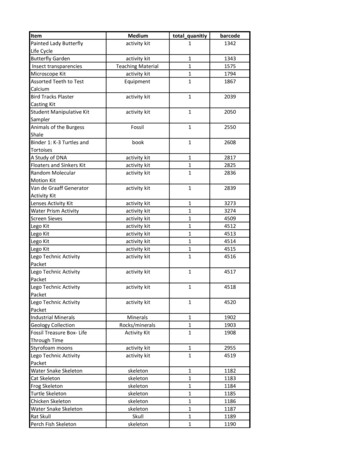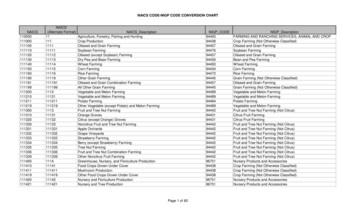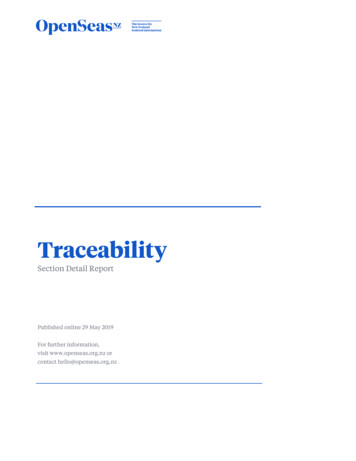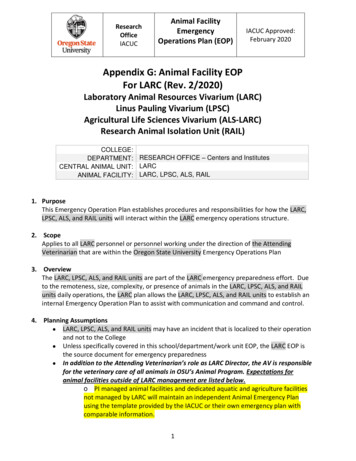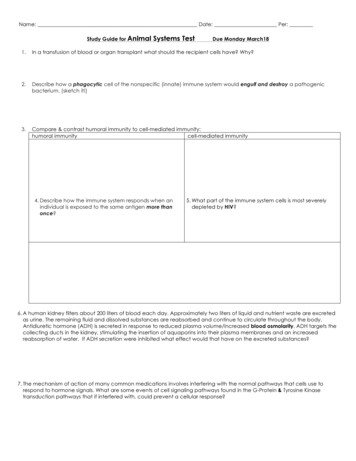
Transcription
Name: Date: Per:Study Guide for AnimalSystems TestDue Monday March181.In a transfusion of blood or organ transplant what should the recipient cells have? Why?2.Describe how a phagocytic cell of the nonspecific (innate) immune system would engulf and destroy a pathogenicbacterium. (sketch it!)3.Compare & contrast humoral immunity to cell-mediated immunity:humoral immunitycell-mediated immunity4. Describe how the immune system responds when anindividual is exposed to the same antigen more thanonce?5. What part of the immune system cells is most severelydepleted by HIV?6. A human kidney filters about 200 liters of blood each day. Approximately two liters of liquid and nutrient waste are excretedas urine. The remaining fluid and dissolved substances are reabsorbed and continue to circulate throughout the body.Antidiuretic hormone (ADH) is secreted in response to reduced plasma volume/increased blood osmolarity. ADH targets thecollecting ducts in the kidney, stimulating the insertion of aquaporins into their plasma membranes and an increasedreabsorption of water. If ADH secretion were inhibited what effect would that have on the excreted substances?7. The mechanism of action of many common medications involves interfering with the normal pathways that cells use torespond to hormone signals. What are some events of cell signaling pathways found in the G-Protein & Tyrosine Kinasetransduction pathways that if interfered with, could prevent a cellular response?
8. The endocrine system incorporates feedback mechanisms that maintain homeostasis. Describe the negative feedback bythe endocrine system that regulates blood glucose levels after a meal. (use concepts: beta and alpha cells, pancreas,insulin, glucagon, glycogen). What can go wrong with this feedback loop if diabetes mellitus were to occur?9. What is acetylcholine (Ach)? As depicted in the pictures to the right, what effectdoes Ach have on muscle cells?What is Acetylcholinesterase? Why is itimportant?10. The illustration to the right depicts a neuromuscularjunction (where the nerve signal is transmitted to a musclecell) of a patient with an autoimmune disorder. What doesthe presence of the antibody have on the nerve impulse?11. During the fall, a chipmunk experiences a sustained period of cold weather. The chipmunk’s thyroid gland responds bysecreting a greater quantity of thyroxin. What glands, cells and hormones are involved in the regulation of thyroxine?12. For the image of the nephron of the kidney to the right, identify the characteristicsof the fluid that passes through each portion/tubule of the nephron labeled A, B, C,D. What happens at each location?A.B.C.D.
13. Fill in the tablebelowFishMammals/birdsinsectsAmphibiansMeans of Gasexchange (organs,surfaces, strategies)Commonality in GasExchange (what dothey all have incommon?)Single cells, Insects, Fish, Mammals, Amphibians, & BirdsFishMammalsReptiles/BirdsThermoregulation & GasexchangeThermoregulation & Gas/Solutes ExchangeThermoregulationMethod of Excreting ofammonia (N-waste);energy required for thismethod? Why is itbeneficial?COUNTER CURRENTEXCHANGE & What itsused for, what isaccomplishes14. During fertilization human females where & how do sperm and egg meet to form a zygote? (acrosomes, Fusion, Haploid,Diploid, Oogenesis, polar bodies). What would cause twins to form?15. What is parthenogenesis?
16. Summarize the 4 stages of embryonic development. Include names of structures? When does differentiation begin?a.b.c.What happens to:Endoderm:Mesoderm:Ectoderm:d.(include Neurulation)17. What is induction? What is Morphogenesis? What is the role of Morphogens?18. The diagram to the right shows a developing worm embryo at the four-cell stage.Experiments have shown that when cell 3 divides, the anterior daughter cell gives riseto muscle and gonads and the posterior daughter cell gives rise to the intestine.However, if the cells of the embryo are separated from one another early during thefour-cell stage, no intestine will form. Other experiments have shown that if cell 3 andcell 4 are recombined after the initial separation, the posterior daughter cell of cell 3will once again give rise to normal intestine. What might explain how the cellsrespond when together compared to how they respond when separated?19. How is Oxygen transported in the blood? What are the 3 ways is carbon dioxide transported in human blood? (whichmethod holds majority of CO2?20. Both myoglobin and hemoglobin are proteins that bind reversibly with molecularoxygen. The graph to the right shows the oxygen-binding saturation of each proteinat different concentrations of oxygen. What can be said about the differences inhow hemoglobin and Myoglobin become saturated with Oxygen under equal partialpressures [concentrations]?What events in the human body could enhance the reaction Hb(O2)4 Hb 402 where Hb hemoglobin? (release of O2from Hb/ affect the amount of oxygen carried by the blood)?
21. What causes the release of epinephrine (adrenaline) from the adrenal glands?22. Summarize the role of each organ of the digestive system in mammalian Digestion:a. Mouth (Amylase)b.Esophagusc.Stomach (pepsin, HCL)d.Small intestine (Bile, Lipase, Trypsin, Secretin, absorption of nutrients, villi)PancreasLiverGall Bladdere.Large Intestine (bacteria, Vitamins, Water)23. The following information was gathered from a study to determine the relationship between structure and function in thedigestive tracts of several animals.Mode ofIntestinalBody sof DigestiveTract PresentPercentage ofIngested NutrientsRemaining in FecesExtensivebranchingVilli andfolds in wallVilli andfolds in wallMouth, pharynx,intestineMouth, esophagus, stomach,intestine, accessory organs, anusMouth, esophagus, stomach,intestine, accessory organs, anus30% of ingestednutrients remaining15% of ingestednutrients remaining11% of ingestednutrients remaining1 Carnivore0.01 m0.01 m2 Carnivore0.10 m0.13m3 Omnivore1.83 m5.62 m4 Herbivore2.59 m7.92 mVilli andfolds in wallMouth, esophagus, stomach,intestine, accessory organs, anus4% of ingestednutrients remaining5 Herbivore1.98 m21.33 mVilli andfolds in wallMouth, esophagus, stomach,intestine, accessory organs, anus10% of ingestednutrients remainingWhat can be concluded about the relationship between intestinal length and body size for the organisms in the table?b. Which of the animals is most likely to have, living in specialized areas of its digestive tract, abundant symbiotic bacteriathat break down foods that the animal normally could not digest on its own?c. Which animal has the least specialized digestive system? What might this be like?d. Which animal is most efficient in absorbing the food it consumes?24. What is the role of Anterior pituitary? What are some feedback cycles it participates in?25. Describe the cyclical nature of the estrous/menstrual cycle in mammals as maintained by a feedback system of glands,organs and hormones?
26. Define each of the following:a. antigensb. interferonsc. antibodiesd. histamines27. Describe how each of the following structures uses diffusion or active transport to transport substance across itsmembranes:A. Small intestine (glucose/amino acids)B. Nephron tubules (Na /Cl )C. Capillaries (O2/CO2/White blood cells)D. Alveoli (O2/CO2/Cl-/Water)28. How does the Medulla control?29.In the image above, a nerve impulse results in the moving of Ions in and out of the neuron, changing the membranepotential. Where in the images does the nerve impulse begin? How does membrane potential change at this point? Whatcould prevent a nerve impulse from traveling along the neuron?30. Identify the parts of the Neurons below. Name arestructures found there. Which direction does the impulsetravel through?
Questions 31-32 refer to the following experiment, whichis designed to test the effects of several chemicals on thecontractility of skeletal muscle.A frog femur with the gastrocnemius muscleattached is installed in a bone clamp as indicated inthe accompanying figure. The sciatic nerve leadingto the muscle is attached to a battery via electricalleads. A small weight is suspended from the free endof the Achilles tendon.The entire preparation is rinsed in one of the fivedifferent solutions listed below. A brief stimulus is thenapplied to the sciatic nerve by closing the circuit tothe battery. Three muscle responses are possible, depending on the solution with which the preparation has beenrinsed: (1) the muscle will twitch once normally; (2) the muscle will go into sustained contraction until it is completelyfatigued; and (3) the muscle will remain flaccid and not twitch at all.Substance Addedto Ringer's RinsingSolutionMechanism of ActionNoneProvides an isotonic saline environment for the muscleEDTABinds free calcium ionsBotulinMalathionCurareBlocks the release of acetylcholine from presynapticjunctionsInhibits the enzyme acetylcholinesteraseBinds to the acetylcholine receptor site in the synapseor myoneural junction31. Which of the substances acts as a competitors of acetylcholine?32. Which substance produces a sustained contraction (tetany) after a brief electrical stimulation of the sciatic nerve?33. The first diagram to the right shows the levels of mRNA from twodifferent genes (bicoid and caudal) at different positions alongthe anterior- posterior axis of a Drosophila egg immediately beforefertilization. The second diagram shows the levels of the twocorresponding proteins along the anterior-posterior axis shortlyafter fertilization.What is the reason the caudal protein begins to increase in theposterior end, but not the anterior end despite the presence ofcaudal mRNA in both ends?
34. The Hedgehog protein (Hh) plays a critical role during a certain period of embryo development, but it normally has no rolein adults except for the maintenance of adult stem cells. However, the Hedgehog protein has been detected in 70 percentof pancreatic cancer cell samples. As illustrated in the figures below, the Hedgehog protein binds to an integral membraneprotein receptor known as Patched (Ptc), thus initiating a pathway of gene expression. When Hedgehog is absent, Ptcinhibits another protein known as Smoothened (Smo), which, in turn, blocks the activation of a group of proteins collectivelyknown as the Hedgehog signaling complex (HSC). The inactivation is the result of proteolytic cleavage of one componentof the HSC complex, a transcription factor known as Cubitus interruptus (Ci) (left side). When Hedgehog is present, it binds toPtc, which prevents the inhibition of Smo by Ptc (right side). The result is that Ci remains intact and can enter the nucleus,where it binds to and activates certain genes.One approach to treating patients with pancreatic cancer and other cancers in which the Hedgehog protein is detected isto modify the Hedgehog signaling pathway. Where in the cell can the cell signaling be stopped to prevent transcription ofgenes? (which components may be susceptible to inhibition?)
8. The endocrine system incorporates feedback mechanisms that maintain homeostasis. Describe the negative feedback by the endocrine system that regulates blood glucose levels after a meal. (use concepts: beta and alpha cells, pancreas, insulin, glucagon, glycogen). What can go wrong with this feedback loop if diabetes mellitus were to occur? 9.


